Enhancing Wear Resistance in Functionally Graded Metallic Components: Insights from Nanoindentation and Mechanical Analysis
Abstract
1. Introduction
2. Experimental Procedures
2.1. Specimens and Microstructural Observations
2.2. Nanoindentation Testing
2.3. Wear Resistance Testing
3. Results
3.1. H, H/Er, and Wp/We Distributions
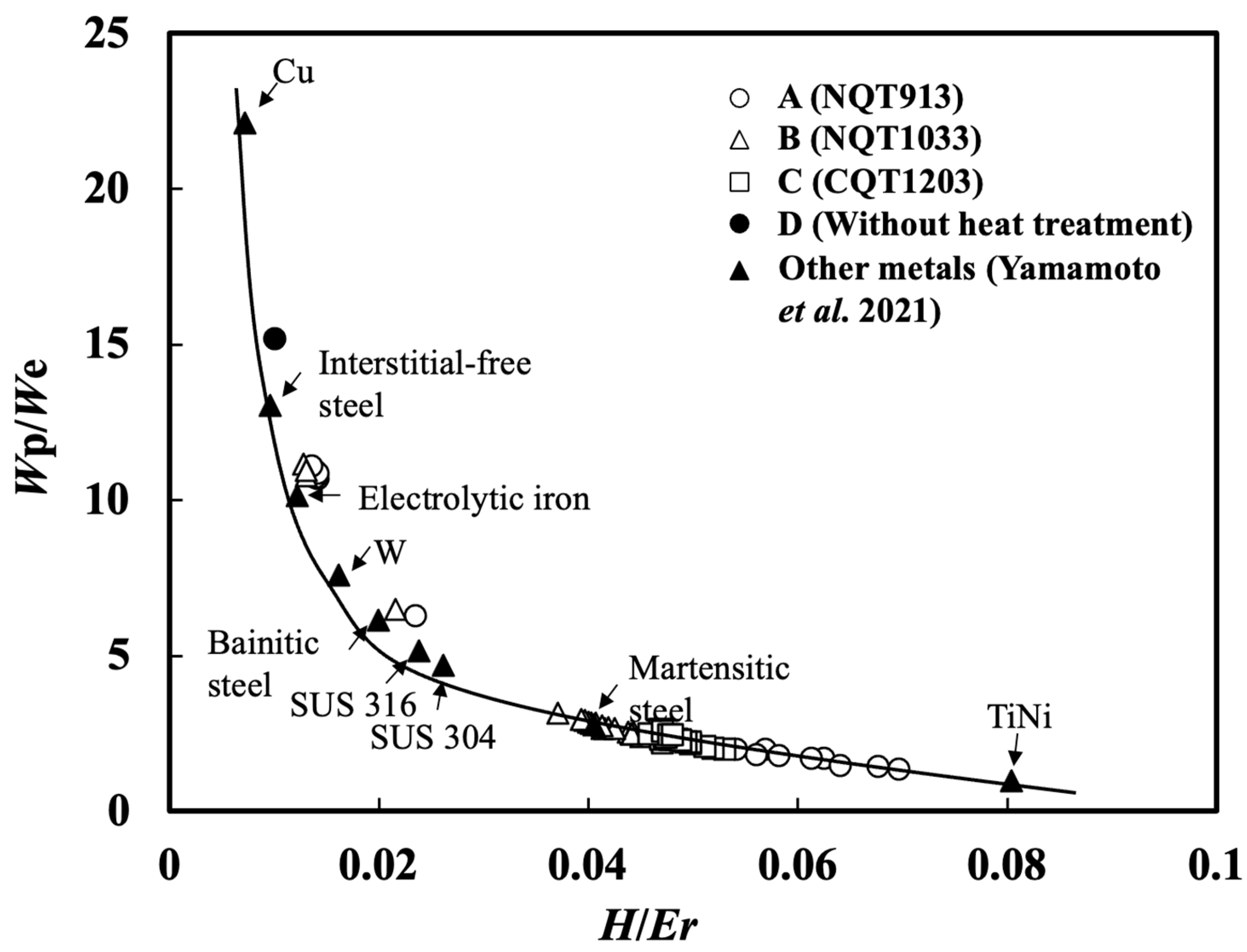
3.2. Microstructural Changes along the Direction Perpendicular to the Specimen Surfaces
3.3. Wear Resistance
4. Discussion
- A noticeable difference in the plastic deformation at the surface (denoted as ℓ0) is observed between NQT913 and NQT1033.
- The depth profile of the wear scar does not replicate the ring shape.
5. Conclusions
- A strong correlation between H/Er and Wp/We was observed along the depth direction for all the specimens, which was described by the formula Wp/We = −1 + 0.16 (H/Er)−1, previously obtained for steels (including stainless steel), high-purity copper, high-purity single-crystal tungsten, and NiTi alloys.
- The surface microstructure of NQT913 was ε-Fe2–3N, which transformed to γ′-Fe4N and then to martensite with increasing depth. In contrast, both NQT1033 and CQT1203 maintained the martensite phase at all depths, while the No HT sample contained ferrite.
- The wear scar width of NQT913 indicating surface plastic deformation was smaller than that of the NQT1033, CQT1203, and No HT samples.
- The wear volume at a sliding distance of 376.8 m decreased in the order of No HT, NQT913, CQT1203, and NQT1033; however, at a sliding distance of 753.6 m (the maximum distance tested), it decreased in the order of No HT, NQT913, NQT1033, and CQT1203. These results suggest that the wear resistance ranking for the carbon-treated and nitrogen-treated specimens varies with the sliding distance.
- The average H/Er av measured beneath the specimen surface displayed a good correlation with the wear volume at the initial stage of the wear.
Author Contributions
Funding
Institutional Review Board Statement
Informed Consent Statement
Data Availability Statement
Conflicts of Interest
Nomenclature
| H | Hardness |
| KN | Nitriding potential |
| NQT | Nitriding–quenching–tempering |
| CQT | Carburising–quenching–tempering |
| NoHT | Hot-rolled specimen |
| FGM | Functionally graded material |
| E | Young’s modulus |
| Er | Reduced Young’s modulus |
| H/Er | Elastic strain resistance |
| Wt | Total deformation energy |
| We | Elastic deformation energy |
| Wp | Plastic deformation energy |
| MWCNTs | Multiwalled carbon nanotubes |
| Near-surface H | H at 2 µm from the surface |
| fcc | Face-centred cubic |
| bcc | Body-centred cubic |
| hcp | Hexagonal close-packed |
| H av | Mean H value from the surface to the sliding depth measured at 5 µm intervals based on the specimen profile |
| H/Er av | Mean H/Er value from the surface to the sliding depth measured at 5 µm intervals based on the specimen profile |
| Wp/We av | Mean Wp/We value from the surface to the sliding depth measured at 5 µm intervals based on the specimen profile |
References
- Bressan, J.D.; Daros, D.P.; Sokolowski, A.; Mesquita, R.A.; Barbosa, C.A. Influence of hardness on the wear resistance of 17–4PH stainless steel evaluated by the pin-on-disc testing. J. Mater. Process. Technol. 2008, 205, 353–359. [Google Scholar] [CrossRef]
- Buchwalder, A.; Klose, N.; Zenker, R.; Engelmann, M.; Steudtner, M. Utilisation of PVD hard coating after electron beam surface treatment for cast iron. HTM J. Heat Treat. Mater. 2016, 71, 258–264. [Google Scholar] [CrossRef]
- Kondul, B.; Cetin, M.H. Increasing the wear resistance of railway switches with boron coating and analysis of tribological performance by ANOVA method. Wear 2022, 488–489, 204132. [Google Scholar]
- Williamson, E.H.; Gee, M.; Robertson, D.; Watts, J.F.; Whiting, M.J.; Yeomans, J.A. A comparative study of the wear performance of hard coatings for nuclear applications. Wear 2022, 488–489, 204124. [Google Scholar]
- Kowalski, S. Influence of diamond-like carbon coatings on the wear of the press joint components. Wear 2021, 486–487, 204076. [Google Scholar]
- Gonzalez-Garmona, J.M.; Mambuscay, C.L.; Ortega-Portilla, C.; Hurtado-Macias, A.; Piamba, J.F. TiNbN Hard Coating Deposited at Varied Substrate Temperature by Cathodic Arc: Tribological Performance under Simulated Cutting Conditions. Materials 2023, 16, 4531. [Google Scholar] [CrossRef]
- Özkan, D.; Yilmaz, M.A.; Karakurt, D.; Szala, M.; Walczak, M.; Bakdemir, S.A.; Tüküz, C.; Sulukan, E. Effect of AISI H13 Steel Substrate Nitriding on AlCrN, ZrN, TiSiN, and TiCrN Multilayer PVD Coatings Wear and Friction Behaviors at a Different Temperature Level. Materials 2023, 16, 1594. [Google Scholar] [CrossRef]
- Ganeshkumar, S.; Singh, B.K.; Kumar, S.D.; Gokulkumar, S.; Sharma, S.; Mausam, K.; Li, C.; Zhang, Y.; Eldin, E.M.T. Study of Wear, Stress and Vibration Characteristics of Silicon Carbide Tool Inserts and Nano Multi-Layered Titanium Nitride-Coated Cutting Tool Inserts in Turning of SS304 Steels. Materials 2022, 15, 7994. [Google Scholar] [CrossRef]
- Yelemessov, K.; Baskanbayeva, D.; Martyushev, N.V.; Skeeba, V.Y.; Gozbenko, V.E.; Karlina, A.I. Change in the Properties of Rail Steels during Operation and Reutilization of Rails. Metals 2023, 13, 1043. [Google Scholar] [CrossRef]
- Balanovskiy, A.E.; Astafyeva, N.A.; Kondratyev, V.V.; Karlina, A.I. Study of mechanical properties of C-Mn-Si composition metal after wire-arc additive manufacturing (WAAM). CIS Iron Steel Rev. 2021, 22, 66–71. [Google Scholar] [CrossRef]
- Davis, J.R. Surface Hardening of Steels: Understanding the Basics; ASM International: Materials Park, OH, USA, 2003. [Google Scholar]
- Parrish, G. Carburizing: Microstructures and Properties; ASM International: Materials Park, OH, USA, 1999. [Google Scholar]
- Krauss, G. Microstructures and properties of carburized steels. In ASM Handbook, Heat Treating of Irons and Steels; ASM International: Materials Park, OH, USA, 1990; Volume 4, pp. 363–375. [Google Scholar]
- Takeuchi, J.; Inoguchi, T.; Ishihara, T. Low temperature quenching of steel (L-TEQ method). J. Jpn. Soc. Heat Treat. 1981, 1, 26–31. [Google Scholar]
- Sommer, M.; Hoja, S.; Steinbacher, M.; Fechte-Heinen, R. Investigation of compound layer structures after nitriding and nitrocarburizing of quenched and tempered steels. HTM J. Heat Treat. Mater. 2021, 76, 219–236. [Google Scholar] [CrossRef]
- Nakamura, K.; Shimizu, T.; Kinoshita, Y.; Masuda, M.; Umebayashi, Y.; Kabasawa, H. Production Engineering Technology of differential roller Gear in Valvematic System. Toyota Tech. Rev. 2009, 56, 113–117. [Google Scholar]
- Hawryluk, M.; Janik, M.; Zwierzchowski, M.; Lachowicz, M.M.; Krawczyk, J. Possibilities of Increasing the Durability of Dies Used in the Extrusion Process of Valve Forgings from Chrome-Nickel Steel by Using Alternative Materials from Hot-Work Tool Steels. Materials 2024, 17, 346. [Google Scholar] [CrossRef] [PubMed]
- Çelic, G.A.; Atapek, Ş.H.; Polat, Ş.; Obrosov, A.; Weiß, S. Nitriding Effect on the Tribological Performance of CrN-, AlTiN-, and CrN/AlTiN-Coated DIN 1.2367 Hot Work Tool Steel. Materials 2023, 16, 2804. [Google Scholar] [CrossRef] [PubMed]
- Kochmański, P.; Długozima, M.; Baranowska, J. Structure and Properties of Gas-Nitrided, Precipitation-Hardened Martensitic Stainless Steel. Materials 2022, 15, 907. [Google Scholar] [CrossRef]
- Hassan, A.F.; Abood, A.M.; Khalaf, H.I.; Farouq, W.; Khazal, H. A review of functionally graded materials including their manufacture and applications. Inter. J. Mech. Eng. 2022, 7, 744–755. [Google Scholar]
- Greenwood, J.A.; Williamson, J.B.P. Contact of normally flat surfaces. Proc. R. Soc. Lond. A Lon. A 1966, 295, 300–319. [Google Scholar]
- Leyland, A.; Matthews, A. On the significance of the H/E ratio in wear control: A nanocomposite coating approach to optimised tribological behaviour. Wear 2000, 246, 1–11. [Google Scholar] [CrossRef]
- Halling, J. The tribology of surface coatings, particularly ceramics. Proc. Inst. Mech. Eng. Part C J. Mech. Eng. Sci. 1986, 200, 31–40. [Google Scholar] [CrossRef]
- Furukimi, O.; Katafuchi, H.; Aramaki, M.; Kozin, M.; Oue, S.; Yoshida, K.; Narita, I.; Yamada, N.; Yamamoto, M. Wear resistance of industrial pure iron treated by nitriding and quenching followed by aging process. Mater. Trans. 2016, 57, 1587–1592. [Google Scholar] [CrossRef]
- Aramaki, M.; Kozin, M.; Yoshida, K.; Furukimi, O. Effects of nitriding-quenching and carburizing-quenching on wear properties of industrial pure iron. J. Heat Treat. Mater. 2018, 73, 131–143. [Google Scholar] [CrossRef]
- Ferro, P.; Bonollo, F. Modelling of the carburizing and quenching process applied to caterpillar track bushings. Modell. Simul. Mater. Sci. Eng. 2014, 22, 025019. [Google Scholar] [CrossRef]
- Okoro, A.M.; Machaka, R.; Lephuthing, S.S.; Oke, S.R.; Awotunde, M.A.; Olubambi, P.A. Nanoindentation studies of the mechanical behaviours of spark plasma sintered multiwall carbon nanotubes reinforced Ti6Al4V nanocomposites. Mater. Sci. Eng. A. 2019, 765, 138320. [Google Scholar] [CrossRef]
- Yamamoto, M.; Tanaka, M.; Furukimi, O. Hardness-deformation energy relationship in metals and alloys: A comparative evaluation based on nanoindentation testing and thermodynamic consideration. Materials 2021, 14, 7217. [Google Scholar] [CrossRef] [PubMed]
- Yang, R.; Zhang, T.; Jiang, P.; Bai, Y. Experimental Verification Analysis of the Relationships between Hardness, Elastic Modulus, and the Work of Indentation. Appl. Phys. Lett. 2008, 92, 231906. [Google Scholar] [CrossRef]
- Cheng, Y.T.; Cheng, C.M. Relationships between hardness, elastic modulus, and the work of indentation. Appl. Phys. Lett. 1998, 73, 614–616. [Google Scholar] [CrossRef]
- Yamamoto, M.; Tanaka, M.; Furukimi, O. Relationship between elastic strain resistance and deformation energy evaluated by indentation test. J. Mater. Test. Res. Assoc. Jpn. 2023, 68, 6–12. (In Japanese) [Google Scholar]
- ISO14577-1; Indentation Hardness. A.4. ISO: London, UK, 2015; pp. 15–23.

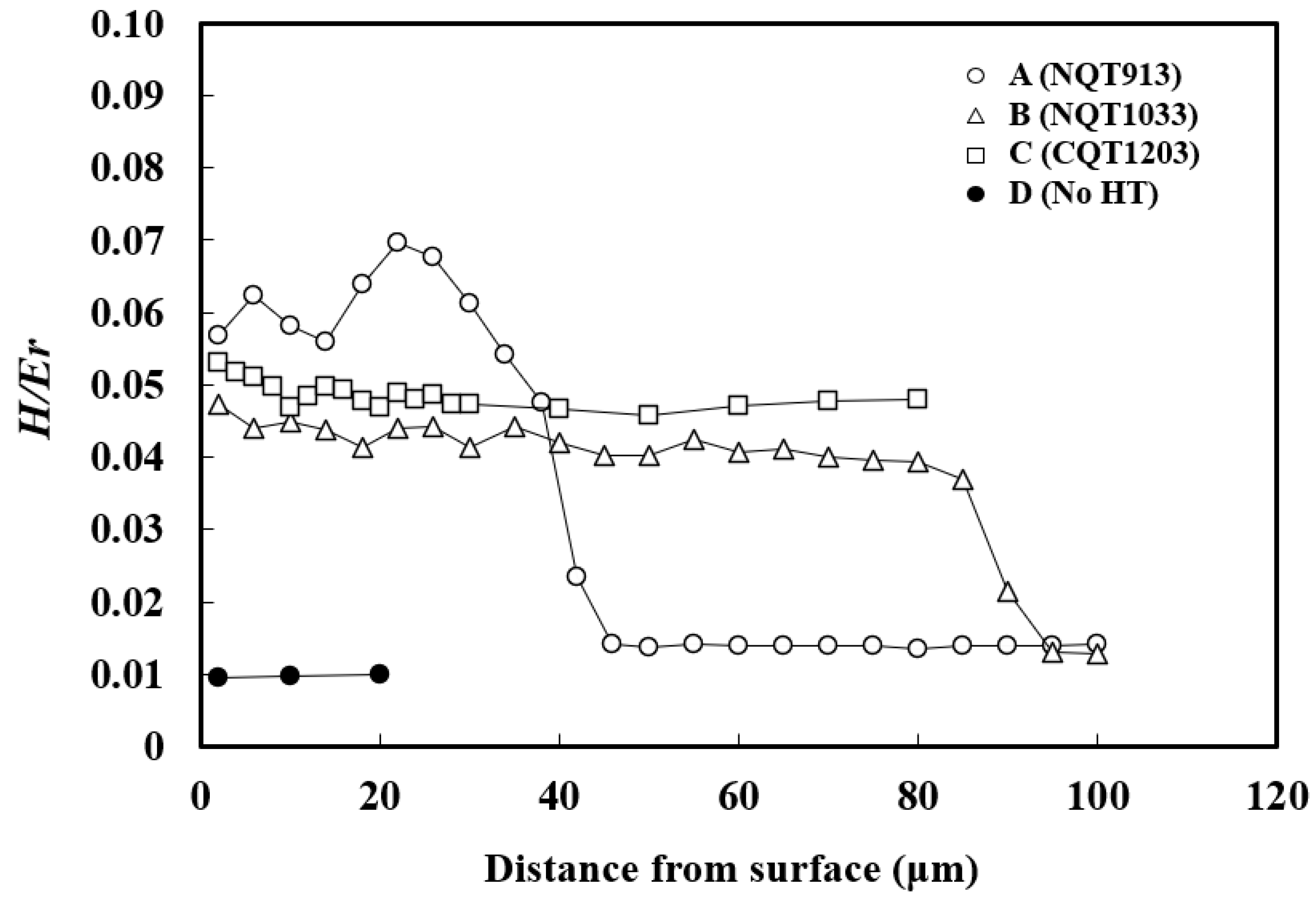
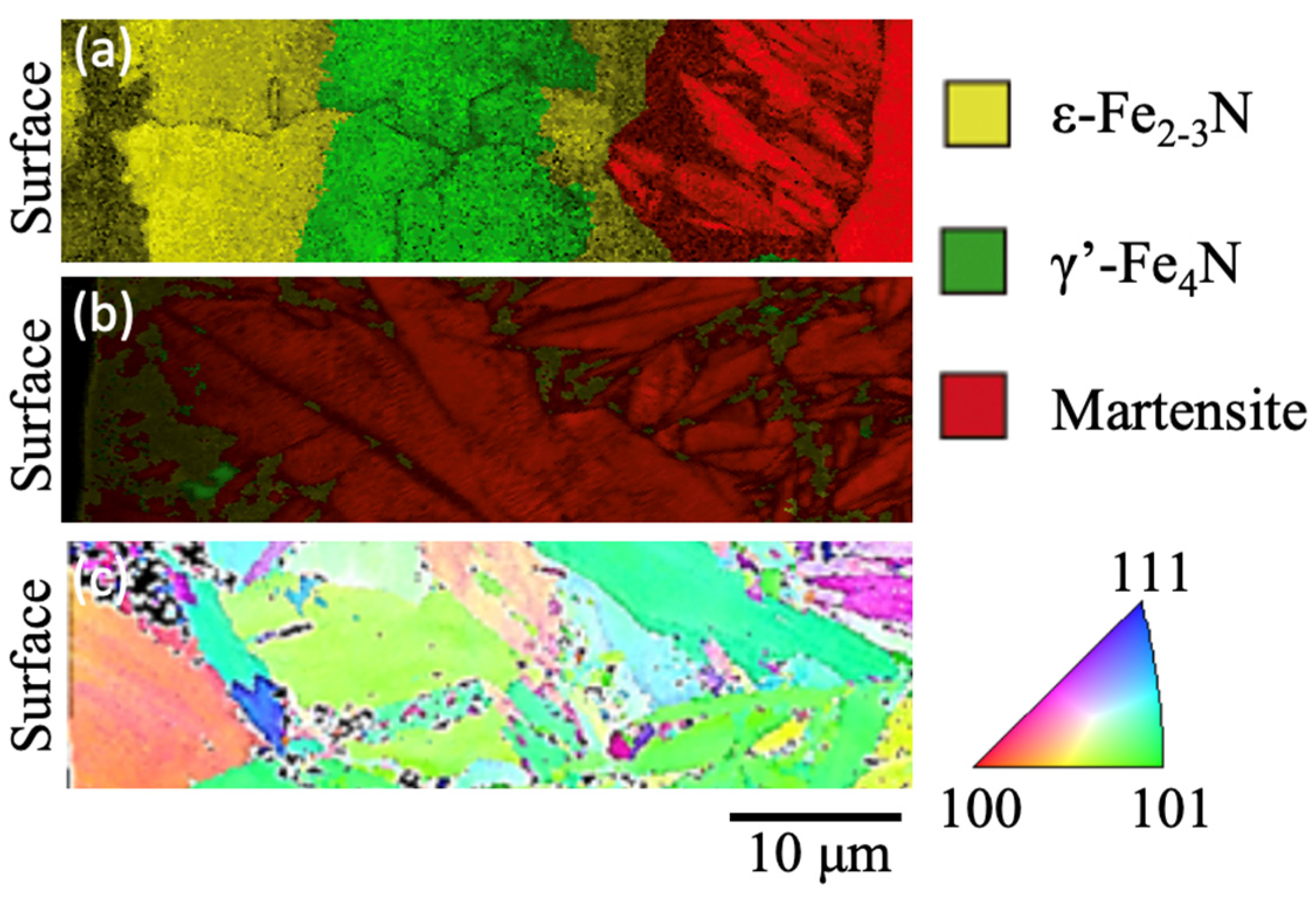

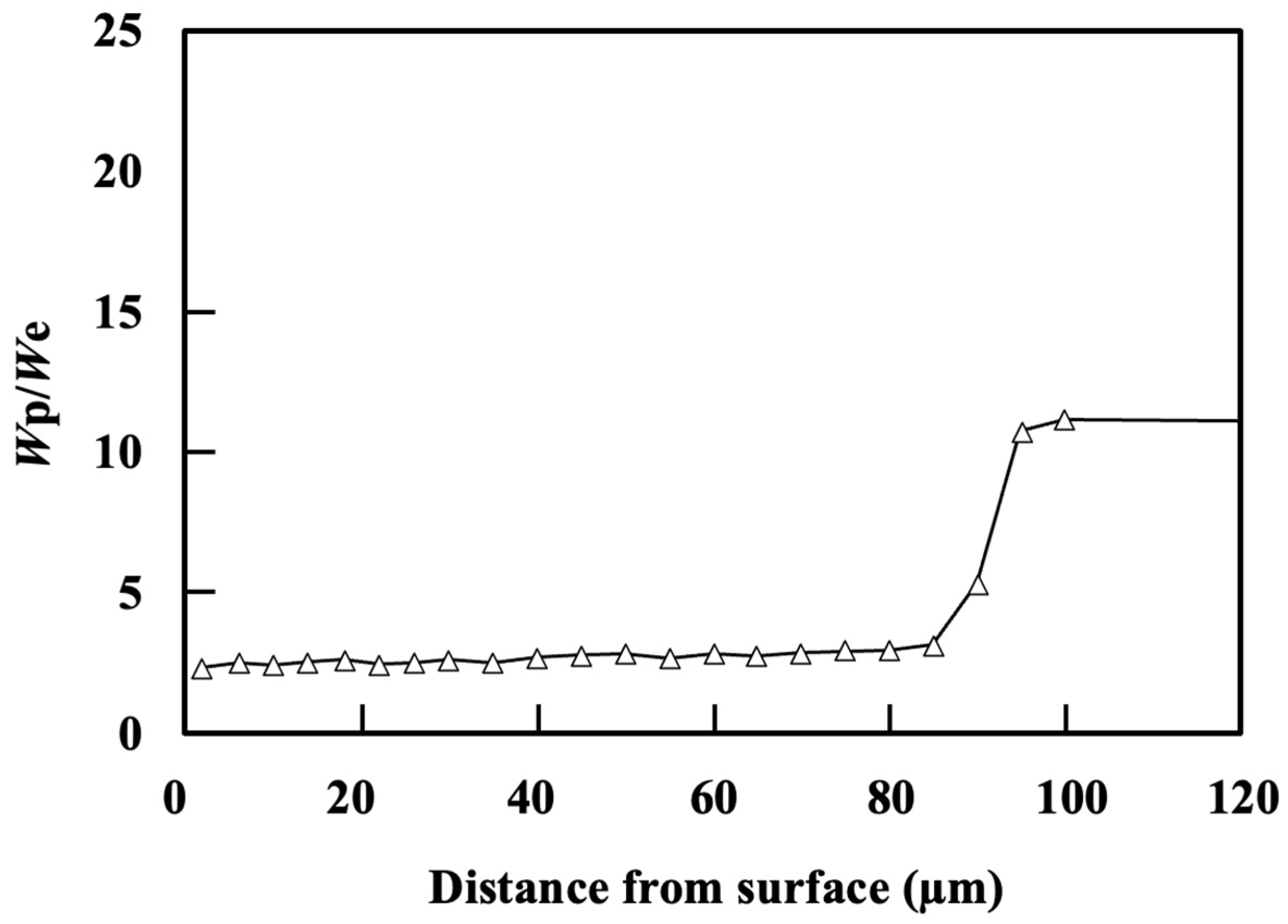
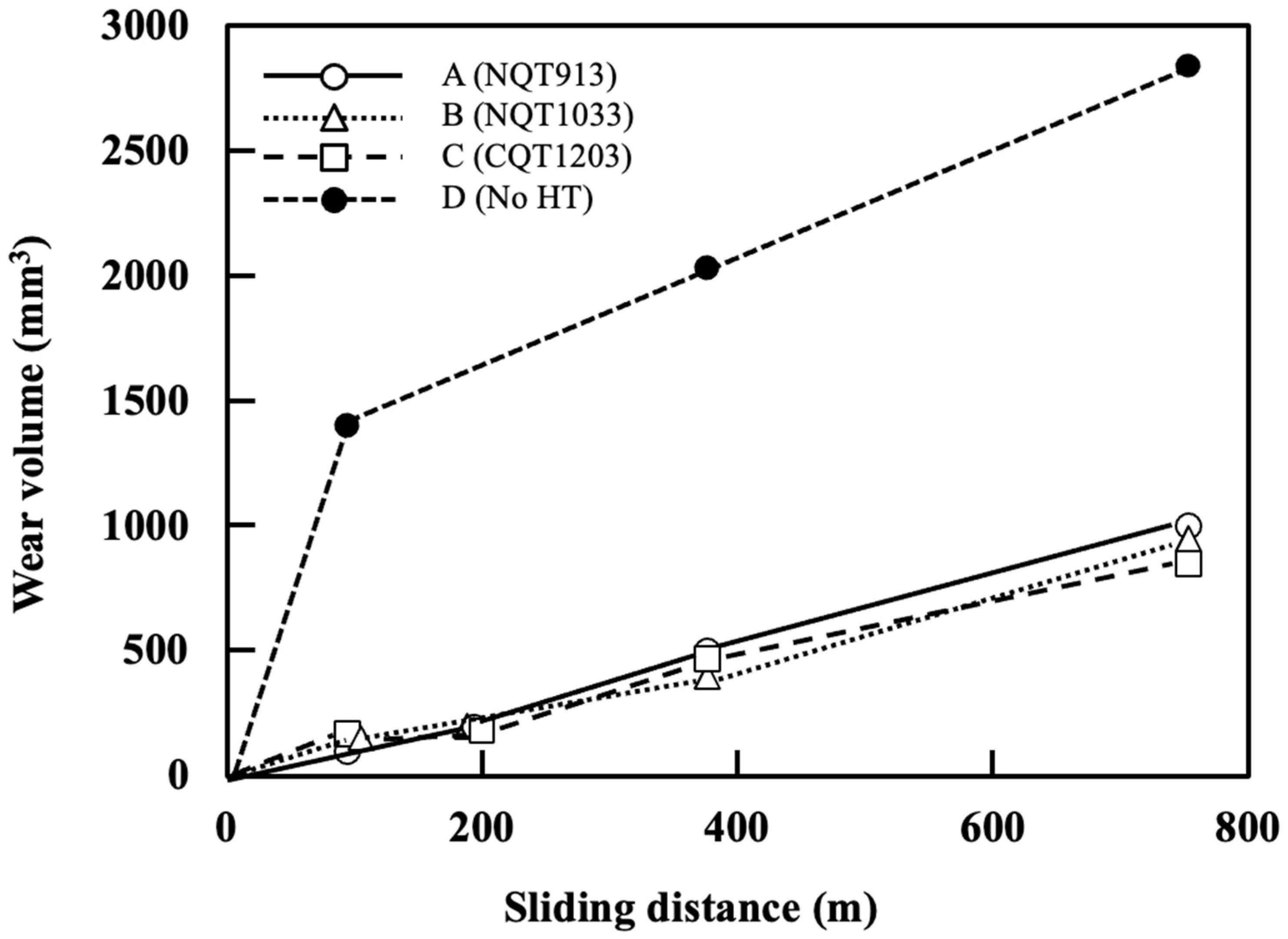
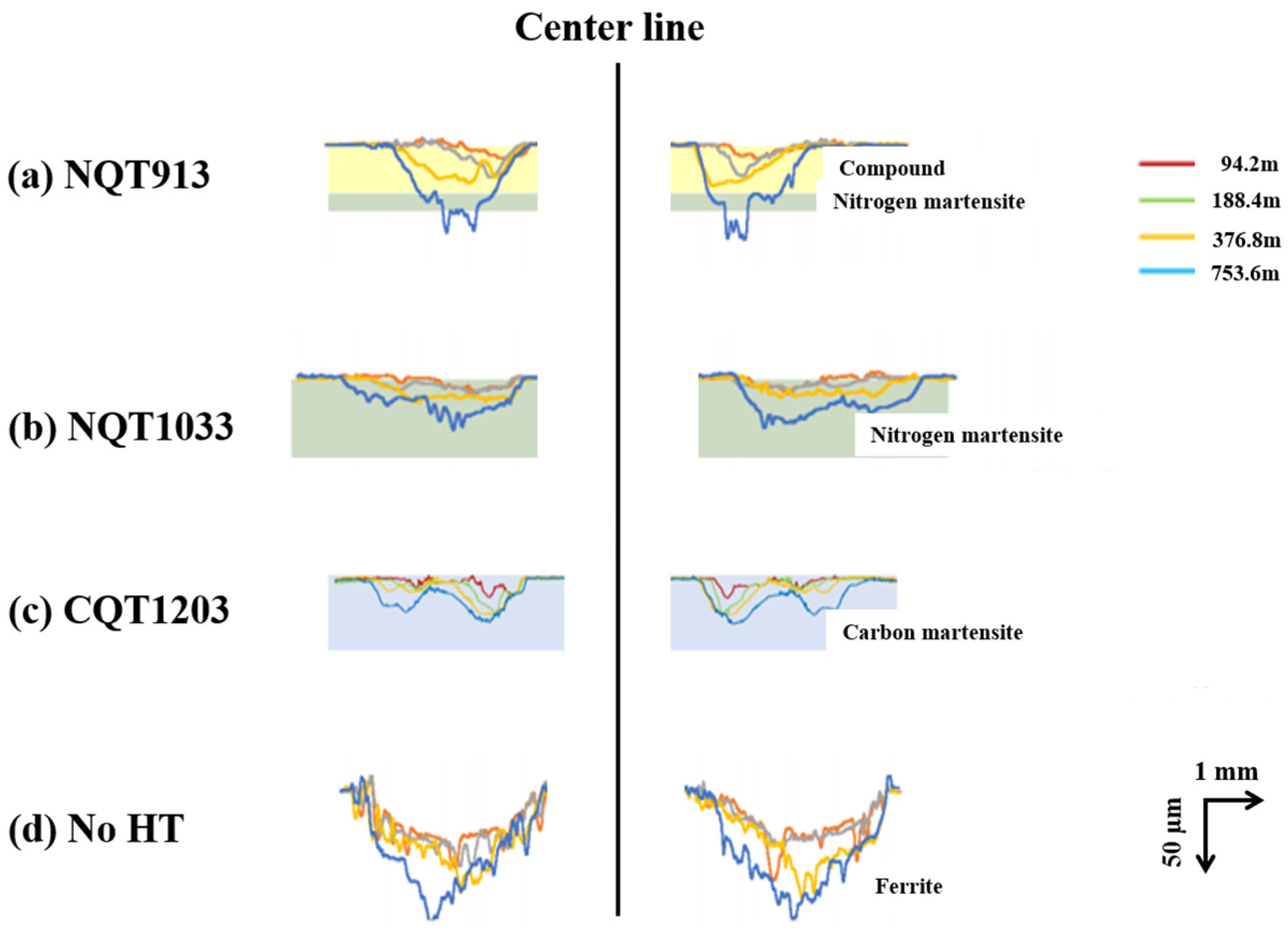
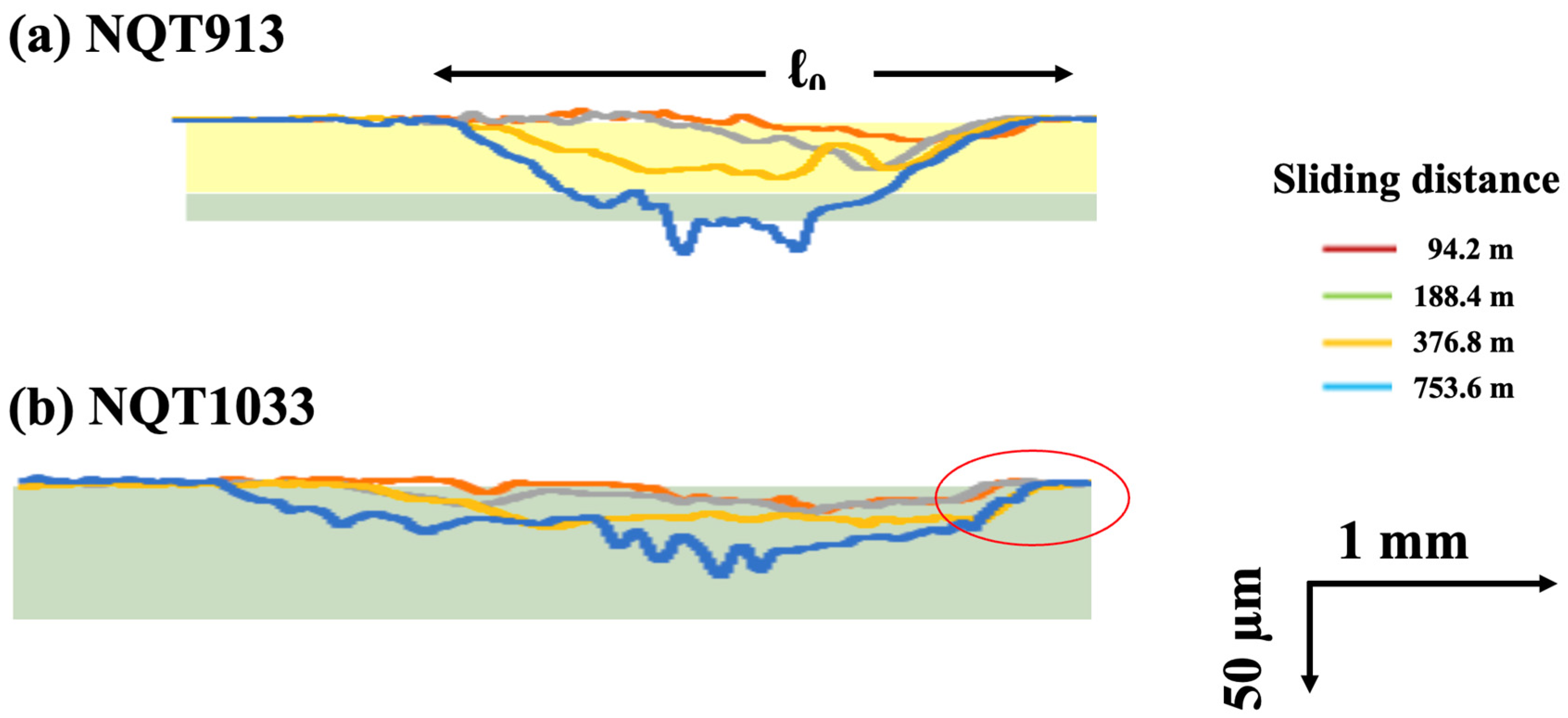
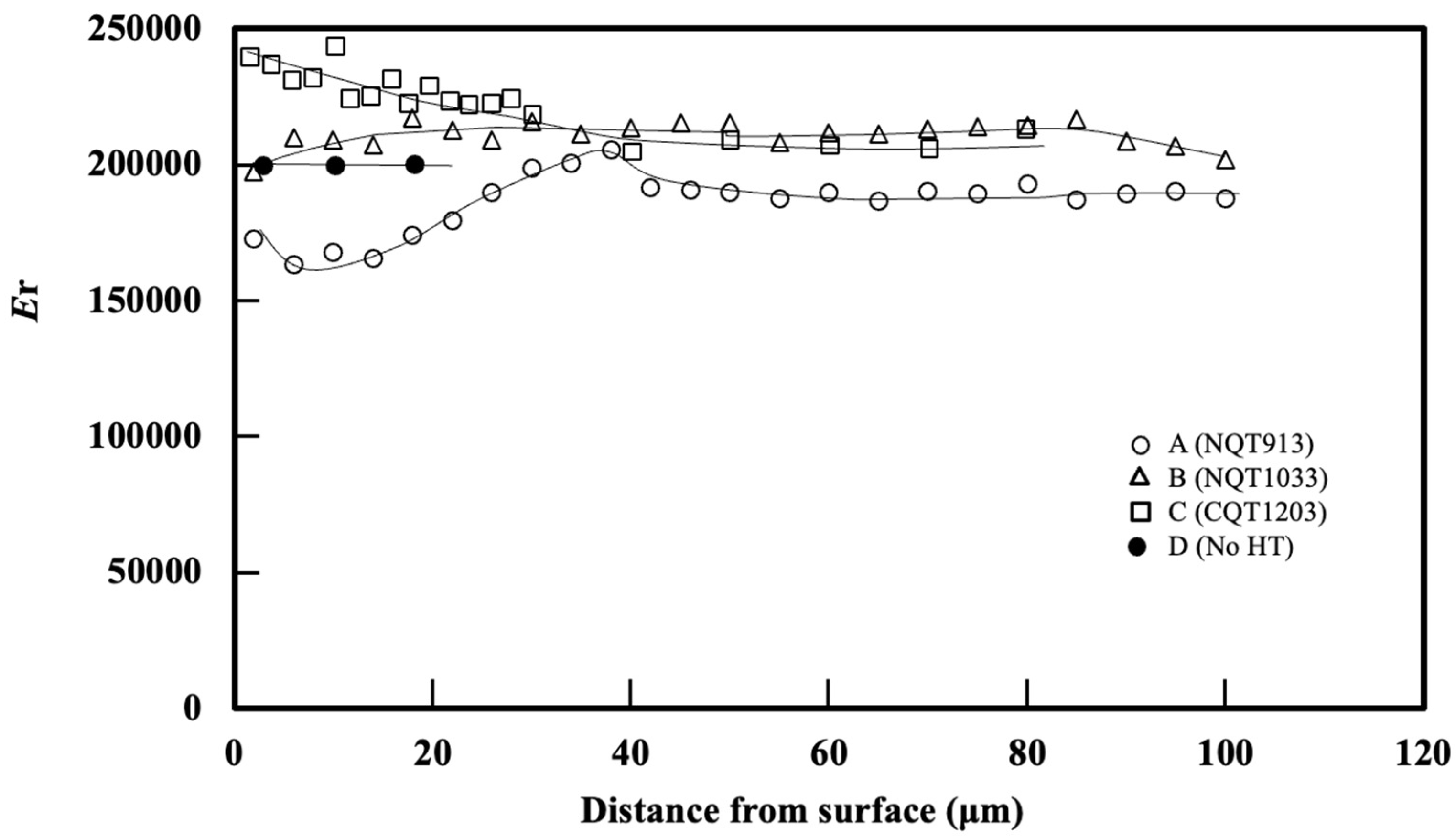

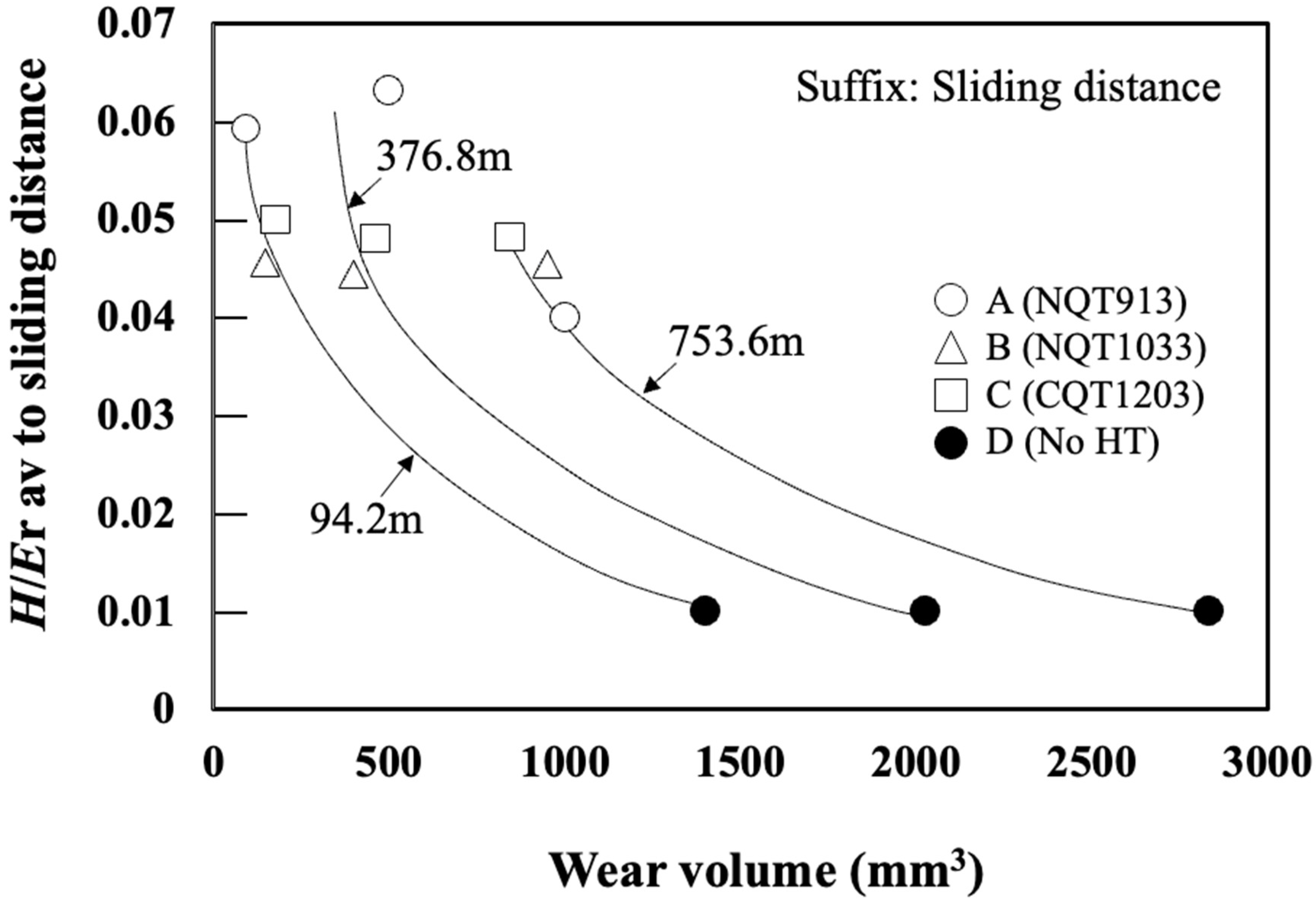
| C | Si | Mn | P | S | Al | N | Fe |
|---|---|---|---|---|---|---|---|
| 0.003 | 0.001 | 0.16 | 0.011 | 0.004 | 0.001 | 0.0017 | Bal. |
| Specimen | Temperature (K) × Time (ks) | |
|---|---|---|
| A | NQT913 | 913 K × 1.8 ks in N2→ 913 K × 5.4 ks in (N2 + NH3) (KN = 0.02): Oil quenching |
| B | NQT1033 | 1033 K × 1.8 ks in N2 (Pressure in furnace = 30 Pa) 1033 K × 5.4 ks in (N2 + NH3) (KN = 0.02): Oil quenching |
| C | CQT1203 | 1203 K × 3.6 ks in C2H2→ 1113 K × 1.8 ks in N2 (C Diffusion): Oil quenching |
| D | NO HT | Without heat treatment |
Disclaimer/Publisher’s Note: The statements, opinions and data contained in all publications are solely those of the individual author(s) and contributor(s) and not of MDPI and/or the editor(s). MDPI and/or the editor(s) disclaim responsibility for any injury to people or property resulting from any ideas, methods, instructions or products referred to in the content. |
© 2024 by the authors. Licensee MDPI, Basel, Switzerland. This article is an open access article distributed under the terms and conditions of the Creative Commons Attribution (CC BY) license (https://creativecommons.org/licenses/by/4.0/).
Share and Cite
Furukimi, O.; Kabasawa, H.; Yamamoto, M.; Protasius, R.; Tanaka, M. Enhancing Wear Resistance in Functionally Graded Metallic Components: Insights from Nanoindentation and Mechanical Analysis. Materials 2024, 17, 1567. https://doi.org/10.3390/ma17071567
Furukimi O, Kabasawa H, Yamamoto M, Protasius R, Tanaka M. Enhancing Wear Resistance in Functionally Graded Metallic Components: Insights from Nanoindentation and Mechanical Analysis. Materials. 2024; 17(7):1567. https://doi.org/10.3390/ma17071567
Chicago/Turabian StyleFurukimi, Osamu, Hitoshi Kabasawa, Masayuki Yamamoto, Roonie Protasius, and Masaki Tanaka. 2024. "Enhancing Wear Resistance in Functionally Graded Metallic Components: Insights from Nanoindentation and Mechanical Analysis" Materials 17, no. 7: 1567. https://doi.org/10.3390/ma17071567
APA StyleFurukimi, O., Kabasawa, H., Yamamoto, M., Protasius, R., & Tanaka, M. (2024). Enhancing Wear Resistance in Functionally Graded Metallic Components: Insights from Nanoindentation and Mechanical Analysis. Materials, 17(7), 1567. https://doi.org/10.3390/ma17071567






